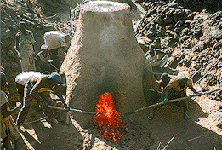
TiniestChemist - 14-11-2014 at 04:25
Is there any way to make Carbon (Graphite, Coal, Charcoal, Coke, amorphous) burn fast enough to reduce Iron from it's oxides (and melt it) without
help of any active work (blowing, fans, whaterwheel or whatever movement)? Meaning, can these temperatures be achieved passively by just burning coal
passively (letting it burn by itself)?
I think that using powdered Carbon would be enough. If not, then how to increase airflow speed in chimneys? Is circulation of air increased by making
another opening at the bottom of chimney where cold air will enter, and escape on top of chimney? Where is the best position for Charcoal and Iron
oxides to be placed? On top of chimney, in the middle, or bottom?
I know that air is preheated usually, but pipes and other equipment would be needed which I'm not interested in. I'm looking for a method to do this
without any technology, but in a crude, quick, survivalistic, historical fashion.
Praxichys - 14-11-2014 at 05:26
Powdered carbon will make it worse because it will pack tight with no space for air to flow. You definitely need a bellows or something to provide
forced air.
Assuming in this "survival situation" has progressed far enough that you can spend time making charcoal and gathering iron ore, you could have easily
constructed bellows from animal hide and wood.
Try this: http://www.anselm.edu/homepage/dbanach/h-carnegie-steel.htm
Bert - 14-11-2014 at 06:16
Charcoal is capable of performing the reduction of Iron ore with only natural draft. IF you are really clever/experienced at building & running
the furnace.

Original poster: I don't like your name.
[Edited on 14-11-2014 by Bert]
Amos - 14-11-2014 at 06:21
I have heard of a kind of furnace(the name escapes me) that is built in an upright, vertical nature, like one big chimney. There is an opening at the
bottom where charcoal is burned to provide heat(a small tunnel parallel to the ground is optional here, but will make the air entering the main shaft
hotter), as well as several grates or racks within the body of the chimney that are charged with pieces of charcoal and iron ores. By fanning air into
the tunnel at the bottom, you can drive hot air containing carbon monoxide over the iron, and if you get it hot enough, spongy molten iron will slowly
accumulate at the bottom of the furnace.
Dr.Bob - 14-11-2014 at 07:09
Just add liquid oxygen. I guarantee that will make the carbon burn fast. George Gobel is one of my favorite chemistry demo'ers ever. I would like
to try this just once...
https://www.youtube.com/watch?v=sab2Ltm1WcM
https://www.youtube.com/watch?v=UjPxDOEdsX8
macckone - 14-11-2014 at 11:45
The name is a cupola furnace.
These can be forced air or convection draft.
Forced air is also called a blast furnace.
Convection draft is not usually used for iron
But is used for smelting copper ore.
careysub - 14-11-2014 at 12:16
Study up on the African Iron Age - the technologies they developed are the ones you are looking for.
Both a natural draft furnaces and forced draft pit furnaces (with variations) were/are used (the practice has not died out):
http://link.springer.com/article/10.1007%2FBF03220550#page-1
and
http://www.sacredmetallurgy.com/wp-content/uploads/2012/09/S...

